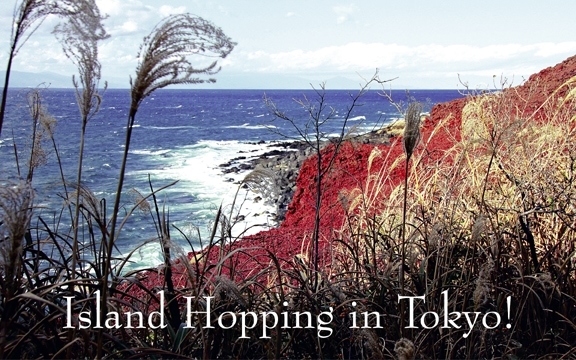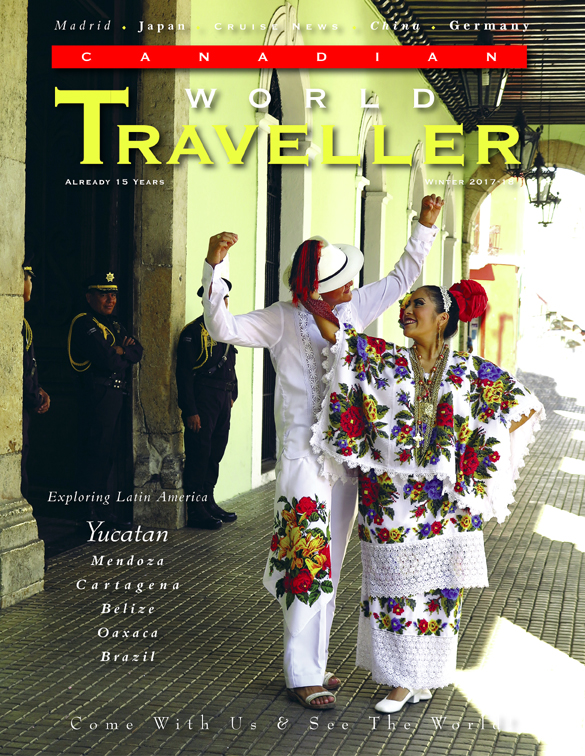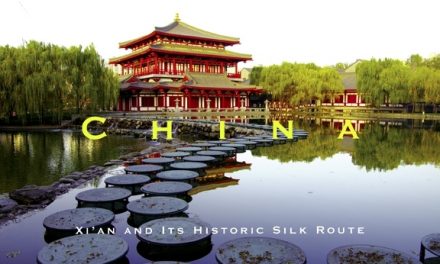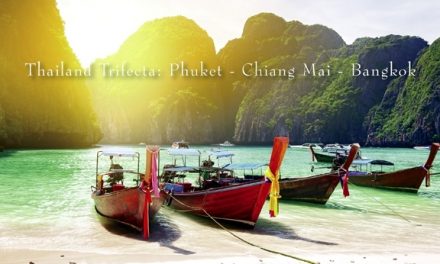Japan
Island Hopping in Tokyo!
Article and photography by Steve Gillick

The heat is on! Those who delight in Japanese cuisine are familiar with freshly grated wasabi, that searing, light green, pungent paste that is often mixed with soy sauce, into which delicate slices of sashimi and sushi are immersed and then savoured.
We expected nothing less when we ordered sashimi at Zakoya Kiyomaru, a seafood restaurant on Tokyo’s Oshima Island. But as we extended our chopsticks to pick up some wasabi, our guide, Kana Nishitani laughingly told us that we were acting like tourists! She explained that wasabi root requires clear river water to grow and no such rivers exist on Oshima. She then picked up a small hot, green pepper (Ao Togarashi) from a dish, drew out the seeds with her chopsticks, and mixed them with the soy sauce. “This is how they do it on Oshima”. We tried it and it was not only fiery, but delicious. (“Umakarai”)
The incident was indicative of what we could expect during our stay on Oshima. First off, ‘heat’ plays a significant role in island activities. Second, the locals have wonderful stories to share, and third is the fact that the Greater Tokyo Area has some amazing attractions that are often overlooked by travelers. In fact the GTA includes over 43 islands (11 of which are habitable), which leads to some incredible opportunities to escape big city tourism and indulge in adventure, commune with nature, sit on a beach, swim in the ocean, explore volcanic craters, eat incredible foods, and meet the friendliest people you can imagine.
Visitors who worry that they may have seen and done everything that Tokyo has to offer, can breathe a sigh of relief, as Island Hopping takes the stage!
Lying 1000 km south of Tokyo are the Ogasawara Islands, accessible by a 24 hour (each way) Ferry ride. Aside from the captivating personalities of the locals, the islands of Chichijima and Hahajima offer activities that include: hidden beaches, secret caves, natural attractions, hiking, boating, sailing, snorkeling, scuba diving, sea-kayaking, fishing, whale-watching and swimming with wild dolphins. Known as ‘The Galapagos of the Orient’, the islands include unique species of flora and fauna, making them a prefect get-away for nature lovers and photographers.
But for something a bit closer to Tokyo, travelers can head to Takeshiba Pier and board the two-hour jet-foil to Oshima, in the Izu Island chain.
Aside from the cuisine, Oshima’s ‘hot’ activities come in two forms. The first are the ‘onsens’ (natural hot springs and public baths), and the second is the volcano.
There are several outdoor onsens where guests can soak to their heart’s content while feeling the wind and listening to the roar of the ocean. Bathing suits are mandatory. But there are also hotels (we stayed at the Oshima Onsen Hotel) where the indoor/outdoor baths provide soothing relief, and bathing suits are prohibited. Either way there’s nothing like hiking 5 hours from the Volcano Mountain sunset lookout, to the Mt. Mihara crater, and on to the Black Desert, and then relaxing in comfortably hot water, while the night sky showcases millions of stars, and the November night air dips to 0C (32F).
Mt. Mihara, Oshima’s active volcano, last erupted in 1986 and is ‘scheduled’ to erupt again in 2021. The Museum of Volcanoes is a great place to see photos of past eruptions and learn how they shaped the Island landscape with trails of lava flows, ancient crater walls, and the volcanic ash (Black) Desert. The Volcano Theatre allows visitors to rumble and vibrate along with a video of the 1986 eruption.
But in the world of travel it’s all about the experience and the best way to get up close and personal with Mt. Mihara is to hike up to the crater itself. At a steady-pace, the whole circuit took about 4 ½ hours to walk. There are a few short, steep slopes but all-in-all it was not a strenuous climb and the vistas were more than rewarding. At times you can leave the path to clamber over lava rocks and boulders. One looked a bit too much like the movie monster Godzilla, and we were reminded that the 1984 movie, The Return of Godzilla, was actually filmed on Oshima. The monster is said to be trapped inside the volcano and this certainly enhanced the power and force of the frightening term “Gojinka” or “God-Fire”, that newspapers used to describe the 1986 eruption.
At the summit, the foreboding Mt. Mihara crater lies before you with water vapour pouring out of underground vents amongst the yellow, orange, red, blue and black rocks.
The island’s volcanic heritage is further revealed toward the south with a trip to the Rock Cut, a surreal mountainside of stratified layers, showing 20,000 years of volcanic activity. Nearby is Sano Hama, one of the island’s black, soft-sand beaches, where surfers congregate.
Further to the south, in Habu (Floating Wave) Port, Tomo, the owner of Tokyo Vone Ten (Tokyo Vision of New Earth Cafe) serves up coffee and Taiyaki, a traditional fish-shaped cake filled with sweet red bean paste. With New Age music playing in the background, Tomo talks about Ebisu, one of the Seven Happy Gods, who influenced him to move from Tokyo to Oshima in 2006 and spread “happy energy”.
And certainly Oshima’s natural attractions and slower pace of life have inspired others. Our guide Kana Nishitani moved to Oshima in 1987 to practice nursing, but ended up teaching Scuba Diving before starting work as a nature guide.
Torao Fujii’s wood carving studio is housed in a yurt-shaped, round building “to promote a calm, soothing atmosphere for coffee and conversation”. He followed in the footsteps of his father who started to carve wooden dolls in the 1930’s to help young people understand the history of the Island, by depicting life in the old days. Fujii-san now conducts wood carving workshops.
And Makito Terada’s company makes salt from sea water. He described his mission as enhancing the enjoyment of Japanese food, based on the fact that salt is an important ingredient in the foods that all Japanese enjoy, including miso, soy and pickles.
Terada-san noted that food is not just a ‘mouth’ thing. “You have to touch it, smell it, breathe the air, experience the scenery and eat with local people”. Only then can you really say that you ate Oshima food and on a larger scale, Japanese food. It’s all about making connections with the destination.
And our own Island connections continued with a visit to Mr. Takada at the Camelia flower press (where cooking and cosmetic oil is made), and a birding excursion with Marimi Gampo, to find the little yellow white-eyed Mejiro.
Island-hopping does not immediately come to mind when planning a trip to Tokyo, but the compelling opportunity awaits for travelers to get away for a day or so and enhance their appreciation of a different lifestyle, experience fascinating scenery, and interact with the wonderful people of Oshima. It’s a remarkable travel adventure just waiting to happen.
www.gotokyo.org/en
Click on cover to view published article






